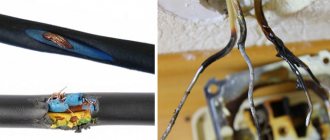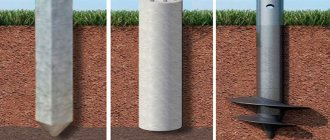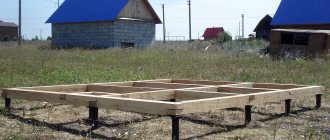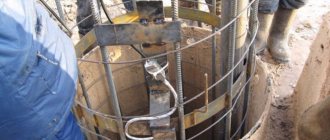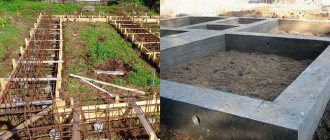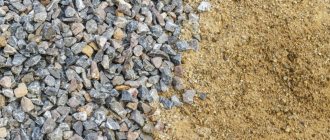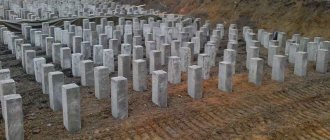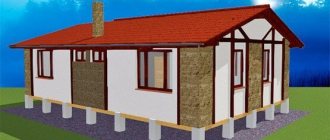Pile-screw foundation for construction
Screw piles are time-tested
The pile-screw type of foundation has been used in the world for about 300 years; it began to be used in the construction of lighthouses; a good example is the Sukhumi lighthouse, which survived the war perfectly and still stands, which indicates the excellent reliability of this type of foundation.
For those who doubt that piles rust and this type of foundation can be unreliable, here is a pile that was replaced at an ancient lighthouse, this pile is more than 300 years old, as you can see, it is perfectly preserved.
Ancient pile from a lighthouse
However, the most popular type of foundation in our country is a strip poured foundation, but not every site can have one, and it is not cheap. There are clayey soils with a high groundwater level; on such land plots it is impossible to build a strip foundation. Then the technology of installing above-ground buildings on a pile-screw foundation comes to the rescue. This type of foundation is also gaining popularity in our country due to many advantages.
Advantages of a pile-screw foundation
- The main advantage is that a pile-screw foundation does not require a large amount of excavation work.
- The technology of its construction is quite simple.
- Speed of installation and efficiency of construction. In an hour on ordinary soil you can install a dozen piles, if you try, you can install all fifteen.
- In addition, its low cost is noted.
- Ability to withstand decent loads and durability.
- Any soil is suitable except rocks.
- The use of special equipment is not necessary; it is possible to install piles manually.
- There is no need to wait after pouring the concrete; you can safely continue building your home.
- There is no vibration or noise during installation
- Piles can be reused
- The foundation for your frame house can always be expanded.
- Possibility of installation on slopes and uneven ground.
Possibility of building a house on a slope, where land is several times cheaper
Disadvantages of screw piles
The disadvantages are actually not so obvious, especially for small frame house construction, this type of foundation is ideal.
But there are still disadvantages:
- Impossibility of construction on rocks or soils with a large number of stones in the soil.
- Suitable for light frame and wooden buildings up to 3-4 floors.
- Houses must have a fairly wide base.
- When screwing in, the anti-corrosion coating is often damaged, which accelerates metal corrosion.
- Poor quality manufacturers.
It is also noted that the service life of a pile-screw foundation, although quite long, is still somewhat shorter than that of a concrete foundation. The service life of such a foundation can also be shortened by damage that the piles sometimes receive during the process of being screwed into the ground. Piles with a damaged outer protective layer are more susceptible to corrosion.
Although a pile-screw foundation is well suited for private construction, it is better not to use it for the construction of heavy massive multi-story buildings.
In addition, there are several other problems that can be encountered when organizing construction on a pile-screw foundation. First of all, you should know that the floor in a house on a pile-screw foundation will require additional insulation. It also often happens that piles shrink unevenly during the operation of the house, and over time they generally become loose if not done according to the technology.
Therefore, despite its strength, a pile-screw foundation is welcome in small-sized construction of frame houses, as well as in the construction of bathhouses, garages and small utility or decorative buildings on the site.
Useful life
Many developers planning to begin construction of residential or industrial facilities are primarily interested in the useful life of a screw foundation. The durability of such a supporting structure is directly affected by the following factors:
- Low acidity of the soil, due to which the supports weaken faster under the influence of corrosion. The proximity of groundwater or other sources of moisture, which are the main cause of rust on piles. The presence of rocky fragments in the soil, the sharp edges of which damage the protective coating and allow moisture to enter welded seams. Temperature fluctuations, which lead to constant compression and expansion of metal structures, due to which their integrity slowly begins to deteriorate. Shrinkage of a building erected on soft soil can cause deformation of metal supports. Violation of technology in the process of constructing a foundation structure, in particularly when deepening piles into the soil.
Disadvantages[ | ]
All building materials and technologies have their drawbacks, which can be eliminated if the rules and regulations of design, production and operation are followed.
| Flaws | Causes | Remedies |
| Possible non-compliance of service life with the requirements of GOST 27751-2014 | When designing the foundation, the corrosive aggressiveness of soils (CAG) and the presence of stray currents are not taken into account. | Carrying out measurements of CAG allows you to calculate the optimal thickness of the barrel wall, select the grade of steel and determine the procedure for reducing corrosion (using zinc anodes, carrying out drainage measures, etc.). As a result, the service life of the foundation meets the requirements of GOST 27751-2014. |
| Possible failure of disaxial screw piles with a shaft diameter of up to 159 mm inclusive when transferring design loads. | The calculation formulas contained in SP 24.13330.2011 do not take into account many features of the joint work of piles and soils, since they are based on simplified interaction models (for example, the Mariupolsky model for anchors). | When calculating the bearing capacity, it is necessary to take into account the results of field soil tests in accordance with GOST 5686-2012. |
| The need to concrete the base of the column or create a rigid interface for single-blade piles of small diameters (57-76 mm) to ensure sufficient resistance to horizontal loads. | Insufficient diameter of the screw pile shaft. | Use modifications of screw piles with an element of resistance to lateral loads. |
| Possible disruption of the soil structure during the immersion of a screw pile, leading to a decrease in bearing capacity. | The calculations take into account the diameter of the blade, but not the configuration. | Select the blade configuration based on data on the soil conditions of the site. |
| Possible reduction in the load-bearing capacity of piles with two or more blades, even relative to single-blade deaxial piles. | Incorrect location of the second and subsequent blades on the trunk. | Assign the distance between the blades, the pitch and the angle of the blades based on data on the soil conditions of the site and the loads from the structure. |
| Uneven distribution of safety margins across the foundations of individual housing construction projects, leading to a decrease in their level of reliability and a reduction in service life. | When assigning screw piles, the different magnitudes of loads acting on the foundation are not taken into account. | Use a specific modification of screw piles for each type of load (under critical nodes, under load-bearing walls, under non-load-bearing walls and floor joists). |
Use of pipes with increased parameters
What measures can be taken to increase the service life of a pile-screw foundation?
- Firstly, an increased margin of safety, that is, the load-bearing capacity of piles, can be used in the calculation. It is safe to say that the larger the diameter of the pipe, the larger its blade, the longer the pile will last. How much does this increase the cost of building a foundation? As a rule, the share of material, or rather the pipe itself, spent on the production of a pile is about 40-50% of its cost, and taking into account installation - no more than 30%. The total cost of the foundation when switching, for example, from 89 pipes to 108, will increase by 15-20%, but the service life of the foundation will correspondingly increase.
- Secondly, if you care about the durability of the foundation, it is recommended to choose piles made of corrosion-resistant steel, for example 30ХМА. Such pipes will be more expensive, but will pay for themselves over time.
- Thirdly, pipes with increased wall thickness can be used. Every 20% of thickness will theoretically increase the cost of the foundation by the same 10-15%, but the service life will increase proportionally.
Ways to increase the service life of a pile
Concreting a support will significantly extend its lifespan
To influence the durability of the pile foundation, the following measures are performed:
- Increase the thickness of the materials from which the blade and pipe are made. Experts say that increasing the thickness of the metal by 1 mm increases the durability of the structure by 20 years if it is used in an aggressive environment. In normal soil, such a foundation will last up to 50 years.
- The use of alloy steel for the manufacture of piles. The physical and chemical characteristics of such a material are significantly superior to ordinary metal. Its corrosion resistance extends the life of the foundation.
- Application of anti-corrosion substances to the surface of the pile. It is necessary to choose the appropriate option for a particular case. The use of hot galvanizing makes it possible to combat atmospheric corrosion, but is useless in case of soil destruction of the foundation. Paint and varnish coatings create physical protection due to the hardness, water resistance, and elasticity of their layer. At the same time, they provide chemical and electrochemical protection. Coatings made of epoxy resins and polyurethane have proven themselves well.
- Concreting the pile. This is a very affordable and effective method; it involves pouring good quality concrete inside the support. Such actions remove air from the inside of the pile and prevent it from collapsing from the inside, so these measures extend the service life of the foundation.
We recommend watching a video showing how to protect the support by applying protective agents.
Protection of the foundation from destruction must be comprehensive, so the pile is not only covered from the outside, but also the internal space of this building element is filled. Experts also recommend:
- Do not skimp on the quality of materials from which the pile is made;
- If possible, do not install a pile foundation at sub-zero temperatures;
- Concrete the internal space of the support in accordance with all building codes, so as not to create additional stress inside the product.
- Hire reputable construction crews, as incorrect screwing can damage the piling blade. Also, poor quality installation work can lead to subsidence or bulging of the pile, which will significantly reduce its service life.
When choosing these products, the first thing that should be wary is the sellers’ assurances that their building products will last for 200 years or more.
Pouring concrete into the internal cavity of screw piles
Separately, we can talk about this method of extending the service of screw piles, such as filling them with concrete after screwing. The fact is that on the inner surface of the pipes there is also an active interaction of the metal with the air saturated with vapors, and, consequently, corrosion occurs, especially since it is problematic to coat the pile with paint or zinc from the inside.
A way to protect the inside of the pipe is to fill the pile with a concrete mixture. After hardening, concrete not only gives the piles additional stability, but also prevents corrosion from the inside.
Filling the pile cavity with concrete
Factors influencing the lifespan of the base
Screw piles can be compared to huge self-tapping screws that are screwed into the ground. They are pipes of different diameters, ending with blades resembling threads.
Such building elements are made of metal or reinforced concrete, so they are endowed with a number of advantages:
- installation and dismantling at any time of the year;
- acceleration of construction work;
- application on unstable soil;
- affordable price.
But in addition to all the advantages, there are a number of factors that influence the durability of the pile foundation. Of these, corrosion should be highlighted. This unpleasant process of metal destruction is divided into the following types:
- chemical;
- electrochemical.
Chemical corrosion
Chemical corrosion occurs when metal comes into contact with oxygen or groundwater located in the soil.
If the acidity level in the soil is high, then destruction processes will occur very quickly. The rate of chemical corrosion depends on the depth of the foundation, since oxygen under the soil layer cannot interact with the metal.
The electrochemical processes of foundation destruction are associated with the contact of the metal of the pile with the soil electrolyte. The rate of corrosion depends on several related factors: the porosity of the earth, the amount of air around, soil moisture, and so on.
Mechanical erosion also has a destructive effect on the foundation. This is a physical effect on the pile, which provokes the destruction of its surface through local cracking. Such influences on the foundation are caused by temperature differences, which provoke contraction and expansion of the metal, as well as the presence of pebbles in the soil, which with their surface provoke the destruction of the pile foundation.
A separate factor influencing the durability of the pile is the technological errors that are made during the manufacture and installation of the specified building element. An untreated pile can be damaged even during transportation, not to mention screwing it into the soil.
Watch a video about the service life of screw supports.
What is the service life of screw piles?
Scheme of types of pile foundations.
Today you can hear that screw piles are the best replacement for any type of foundation, that the service life of such a structure is the highest. But is this really so, can a pile foundation last more than 150 years, as manufacturers claim? In this case, it is easy to verify the service life yourself.
With a pile blade thickness of 5 mm, this value is divided by 0.03 mm per year, i.e., by the corrosion rate. This gives a value of 150 years, which is always mentioned by pile manufacturers. But it's not that simple. For example, for the most ordinary house, a metal pile with a wall thickness of 4 mm and blades of 5 mm is taken. Its weakest point will be the air-ground transition area. With a corrosion of 0.03 mm, the service life will be 130 years, not 150. This value is for moderately corrosive soils with low impact.
There is one more point - the pipe rusts not only from the outside, corrosion also damages it from the inside, even if special treatment is allowed. The absence of oxygen reduces the corrosion rate by only 30%, that is, the service life is already moving to around 85 years, which is almost half less than what was originally stated.
Next, you need to take into account the safety factor. For metal, the permissible value is at the level of 1/3 - for a pipe tip with a load of 5000 kg. What conclusion can be drawn? If you install a pile foundation with deteriorated performance, without performing internal anti-corrosion protection, then the service life will not be 150 years, as the manufacturer indicates, but only about 30 years.
The durability of the screw pile can be slightly increased if the pipe is protected from corrosion from the inside. For this purpose, hot galvanizing, application of so-called cold zinc, bitumen protection, etc. are used. Using a primer is a waste of money that does not bring any benefit, even if their manufacturers shout at every corner about such an effect. In this case, the service life of the piles can be extended to a maximum of 100 years, but only for slightly corrosive soils. Even after 60-70 years there will be no visible signs of damage, although the process may already have started inside.
You cannot rely on the manufacturer’s words for everything, since the declared service life is given for ideal conditions, which are impossible to achieve during normal construction. In reality, the service life of a pile foundation ranges from 40 to 70 years; with further use, severe damage and repair work are already possible. When installing the foundation, it is imperative to provide anti-corrosion protection, since although it does not give the effect that is mentioned, it can still extend the service life by almost half.
Evgeny Dmitrievich Ivanov
Ivan, in this case you need to start from a 10 liter bucket. Fill a full bucket with sand and add 1/3 of cement, mix everything - 10 liters. or.
October 16, 2015
How is ready-mixed concrete calculated for 1 square meter of screed 5 cm thick? How much sand and cement will this require? So as not to buy too much. Want.
October 12, 2015
For different brands of concrete, if measured by volume, then only the ratio of sand and crushed stone to cement changes, and water is always taken exactly half of the volume of cement.
October 20, 2015
Ivan, in this case you need to start from a 10 liter bucket. Fill a full bucket with sand and add 1/3 of cement, mix everything - 10 liters. or.
October 16, 2015
How is ready-mixed concrete calculated for 1 square meter of screed 5 cm thick? How much sand and cement will this require? So as not to buy too much. Want.
October 12, 2015
For different brands of concrete, if measured by volume, then only the ratio of sand and crushed stone to cement changes, and water is always taken exactly half of the volume of cement.
A few additions: 1. If you need to perform high-quality waterproofing with liquid rubber, it is advisable to use geotextiles over the entire surface. Consumption.
September 23, 2015
How and with what to make the upper border of the foundation cladding (natural stone, flagstone)?
Copyright 2014–2017, moifundament.ru
- foundation work
- Reinforcement
- Protection
- Tools
- Installation
- Finishing
- Solution
- Calculation
- Repair
- Device
- Types of foundation
- Tape
- Pile
- Columnar
- Slab
- Other
- About the site
- Questions to the expert
- Editorial
- Contacts
- Work with the foundation Reinforcement of the foundation
- Foundation protection
- Foundation Tools
- Foundation installation
- Finishing the foundation
- Foundation mortar
- Foundation calculation
- Foundation repair
- Foundation structure
- Strip foundation
Service life according to GOST
According to government regulations, the service life of screw piles ranges from 60 to 120 years. GOST also indicates the following data:
- Electromechanical corrosion of metal in soil develops at a rate of 0.02 to 0.05 mm per year.
- The thickness of the walls of the screw and the support itself is at least 5-6 mm.
- The walls of the pipes decay at a rate of 5 mm/0.5 = 100 years.
In addition, the piles are coated with special two-component polymer compounds that retain their properties for 7-15 years. This allows you to increase the service life of screw piles under the foundation. If these conditions were violated during the manufacturing process of the supports, the products will be less reliable and durable.
What is a foundation on screw piles?
Freezing depth and screw piles
The pile-screw foundation appeared a long time ago. Initially, it was used by the military for the rapid construction of various structures for appropriate purposes.
Therefore, the development of foundations on screw piles was carried out by military engineers, who set as their goal to create a foundation that would have unique capabilities in terms of speed of construction and reliability.
Over time, these developments began to be widely used in industrial and civil construction. Oddly enough, in our country, the use of pile-screw foundations began in the north, and only then spread to other regions.
Unlike a strip or monolithic foundation, a pile structure differs in that a project for it can be done for areas that have a complex surface, for example, a continuous slope or significant unevenness, the leveling of which will take a lot of time and money. Thanks to such a foundation, it is possible to preserve the pristine nature of the land if it is located in a picturesque place.
The pile-screw design is a set of hollow metal pipes cased on a cone. The pointed parts of the elements immersed in the ground have auger spirals or screw threads (that’s why they are also called geoscrews). Plates are welded onto opposite ends, serving as mating planes to create a grillage.
Since all structural elements are made of steel, being in the ground, under the influence of moisture and other unfavorable factors, they can be subject to destruction.
Foundation in a section of the soil on screw-type piles
To protect the building support from unwanted processes, the surface of the piles is coated with zinc or other inert metal that is resistant to corrosion. Some experts also recommend treating piles in other possible ways in order to increase their durability.
For example, the majority of manufacturers of screw supports set a service life of more than 30 years for their products. In practice, the period of effective operation reaches at least 50 years. This is due to the fact that high-quality piles, which are manufactured using technology, have a large margin of safety. And in the case of coating the surfaces of products with hot zinc according to the DIN EN ISO 1461 standard, the service life of screw foundations is guaranteed up to 120 years.
Speaking about service life, we should not forget about the depth of immersion of piles. According to general rules, drilling is carried out below the freezing level of the soil.
This is due to the fact that the soil, which does not freeze, has excellent bearing capacity and is not subject to various seasonal movements. The layer that freezes tends to swell, swell when freezing and settle when thawing. For example, a shallow strip foundation will not be able to withstand such temperature fluctuations and will begin to crack.
The piles themselves have different lengths and diameters. If everything is clear with the length, then it’s better to talk about the diameter in more detail. Buildings have different weights and designs. Therefore, piles are produced in different diameters. The larger the diameter, the better the load-bearing properties of the piles.
The main disadvantage of metal piles that are produced in our country is that they cannot be used for powerful and heavy structures - you cannot put a stone palace on them. They are best used for country houses, bathhouses, verandas, various extensions, that is, wooden buildings, frame structures.
Having figured out what such a base is, you can proceed to its installation.
A little bit of history
The pile-screw foundation, like many things in our peaceful sectors of the national economy, has its origins in developments to increase the country's defense capability. Simply put, piles were first used in engineering structures for the army. There were good reasons for this - speed of construction, reliability, significant cost savings, and relative simplicity. And, in the end, the use of cheap labor. All these are important factors in military conditions. However, in everyday life they are no less attractive.
In addition to the mentioned reasons for their attractiveness to the military, it was important that pile-screw foundations turned out to be almost the only option in certain conditions - when erecting in wetlands, with weak soils and with large differences in elevation. This is how they achieved popularity in our industrial construction related to oil and gas production.
Using piles to quickly build a pontoon
Like any military equipment and equipment, screw foundations were designed with a large margin of safety, which cannot be said about ensuring longevity, because military structures were usually built not for centuries, but for the duration of hostilities. The same applies to construction in oil-producing areas - there, too, structures are installed during the production of wells.
However, a huge margin of safety allows them to be used in construction without worrying too much about short service life.
Screw piles as supports for an oil rig
This can be judged by the requirements adopted in Soviet times in relation to screw piles:
- A hot-rolled pipe with a wall thickness of 10-14 mm is used as the body of the pile.
- Pipe diameter – from 0.22 to 0.35 of the blade size
- Pipe length – at least 8 meters
- Blade from 40 to 120 cm
- Spiral pitch 0.15-0.3 diameter
These requirements are many times greater than modern requirements used in construction. However, piles were also used for the foundations of structures that were significantly larger in weight than ordinary low-rise buildings.
Today, the main parameters of piles permitted for the construction of foundations must comply with the following parameters:
- Wall thickness from 4 mm
- Mandatory anti-corrosion coating
- The diameter of the blades is about 25-30 cm
- Resource – 50 years
However, the reasonable use of a pile-screw foundation is limited to the class of light buildings, which include utility structures such as a bathhouse, outbuilding or summer kitchen, as well as wooden frame houses.
Sometimes the calculated load-bearing capacity of a screw pile foundation may be enough to build a not very large brick or block house, but most builders in this case prefer reinforced concrete foundations.
And the reason for this is not only the lower power of the piles, but also their reduced service life.
